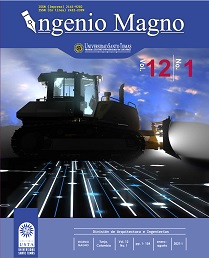Numerical simulation of a capillary rheometry test for a PC+ABS polymer
Main Article Content
Abstract
Downloads
Article Details
DECLARATION OF ORGINIALITY OF SUBMITTED ARTICLE
With this document, I/We certify that the article submitted for possible publication in the institutional journal INGENIO MAGNO of the Research Center Alberto Magno CIIAM of the University Santo Tomás, Tunja campus, is entirely of my(our) own writing, and is a product of my(our) direct intellectual contribution to knowledge.
All data and references to completed publications are duly identified with their respective bibliographical entries and in the citations thus highlighted. If any adjustment or correction is needed, I(we) will contact the journal authorities in advance.
Due to that stated above, I(we) declare that the entirety of the submitted material is in accordance with applicable laws regarding intellectual and industrial property, and therefore, I(we) hold myself(ourselves) responsible for any complaint related to it.
If the submitted article is published, I(we) declare that I(we) fully relinquish publishing rights of the article to the University Santo Tomás, Tunja campus. As remuneration for this relinquishment of rights, I(we) declare my(our) agreement to receive two (2) copies of the edition of the journal in which my(our) article appears.
References
ANSYS Inc. (2013). Fluent User’s Guide: Viscosity for Non-Newtonian Fluids, Cross model. Canonsburg, PA, USA.
AUTODESK. (2015). Help: Cross-WLF viscosity model. Recuperado el 10 de 06 de 2020, de AUTODESK Simulation Moldflow Insight 360: http://help.autodesk.com/view/MFIWS/2015/ENU/?guid=GUID-7BC3A8F0-8B41-4FCBBDF1-F1159E4DD175
Bird, R. B., Stewart, W. E., & Lightfoot, E. N. (2006). Fenómenos de Transporte (2da ed.). Nueva York: Limusa Wiley.
Cengel, Y. A., & Cimbala, J. M. (2006). Mecánica de Fluidos: Fundamentos y Aplicaciones. México, D.F. Mc Graw Hill.
Fernandez, A., Muniesa, M., Javierre, C. (2014). In-line rheological testing of thermoplastics and a monitored device for an injection moulding machine: Application to raw and recycled polypropylene. Polymer Testing, 33, 107-115.
Gou, G., Xie, P., Yang, W., & Ding, Y. (2011). Online measurement of rheological properties of polypropylene based on an injection molding machine to simulate the injection-molding process. Polymer Testing, 30, 826-832.
Khor, C.Y., Ariff, Z.M., Che Ani, F., Abdul Mujeebu, M., Abdullah, M.K., Abdullah, M.Z., Joseph, M.A. (2010). Threedimensional numerical and experimental investigations on polymer rheology in meso-scale injection molding. International Communications in Heat and Mass Transfer, 37(2),
131-139.
Peydro, M.A., Juárez Varón, D., Crespo Amorós, JE., Parres, F. (2011a). Study of rheological behavior of reprocessing polyamide 6. Annals of The University of Oradea, 10(20), 421-425.
Peydró, M.A., Parres, F., Crespo, J.E. and Juárez, D. (2011b), Study of rheological behavior during the recovery process of high impact polystyrene using cross‐WLF model
Reig, M.J., Segui, V.J., & Zamanillo, J.D. (2005). Rheological Behavior Modeling of Recycled ABS/PC Blends Applied to Injection Molding Process, Journal of Polymer Engineering, 25(5), 435-457
Rusdi, M.S., Abdullah, M.Z., Mahmud, A.S., Khor, C. Y., Abdul Aziz, M. S., Ariff, Z. M., Abdullah, M. K. (2016). Numerical Investigation on the Effect of Pressure and Temperature on the Melt Filling During Injection Molding Process. Arab J Sci Eng. 41, 1907–1919.
Vingaard, M. & deClaville Christiansen, J. (2012). Sealing of polymer micro-structures by over-moulding. Int J Adv Manuf Technol, 61, 161–170.

